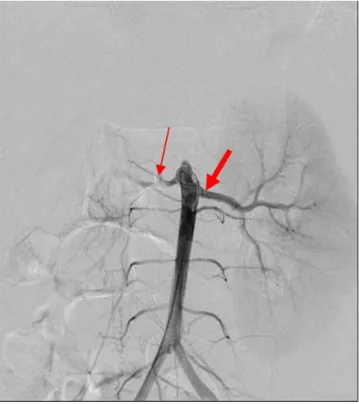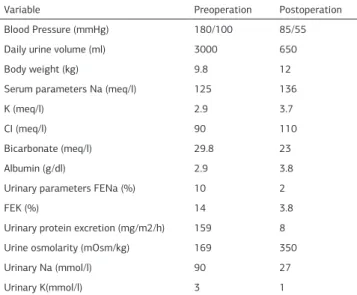Hiponatremik-Hipertansif Sendrom / Hyponatremic-Hypertensive Syndrome
Hyponatremic-Hypertensive
Syndrome in an 18-Month-Old Male Child
Hiponatremik-Hipertansif
Sendromlu 18 Aylık Erkek Çocuk
DOI: 10.4328/JCAM.3908 Received: 30.09.2015 Accepted: 12.10.2015 Printed: 01.12.2015 J Clin Anal Med 2015;6(suppl 6): 883-5
Corresponding Author: Dilek Yılmaz, Division of Pediatric Nephrology, Department of Pediatrics, Adnan Menderes University Faculty of Medicine, Aydın, Turkey. GSM: +905055954369 F.: +90 2562136064 E-Mail: dr.dlkylmz@gmail.com
Özet
Poliüri, polidipsi, hipertansiyon, ciddi hiponatremi, metabolik alkaloz ve nefrotik sı
-nırda proteinürisi olan, 18 aylık erkek olgu sunuldu. Hipertansiyon ilaca dirençliy
-di. Angiografide, sağ renal arter tıkanıklığı saptandı. Böbreğin nükleer taramasın
-da, afonksiyone sağ böbrek tespit edildi. Perkütan renal arter anjiyoplasti, hasta
-mız için uygun olmadığından nefrektomi yapıldı. Tüm bulgular sağ nefrektomiden sonra düzeldi. Çocuklarda hiponatremik hipertansif sendromun nadir olması, onun yeterli bilinmediğini gösterir. Poliürik, hipertansif ve hiponatremik çocuklarda, re
-nal hasarı ve yaşamı tehdit eden komplikasyonları önlemek amacıyla, hiponatre
-mik hipertansif sendromun farkındalığının arttırılması amaçlandı.
Anahtar Kelimeler
Hiponatremi; Hipertansiyon; Renal Arter Darlığı; Poliüri; Hiponatremik-Hipertansif
Sendrom
Abstract
An eighteen-month-old boy presented with polyuria, polydipsia, hypertension, severe hyponatremia, metabolic alkalosis and nephrotic-range proteinuria. Hy
-pertension was drug resistant. Renal artery angiogram revealed right renal ar
-tery occlusion. Nonfunctional right kidney was also detected on the nuclear renal scan. As percutaneous transluminal renal artery angioplasty was not appropriate for our patient, nephrectomy was performed. Right nephrectomy resulted in the
resolution of all the symptoms. Rarity of hyponatremic hypertensive syndrome in
children may project its under-recognition. We aimed to increase awareness of early diagnosis of HHS among polyuric, hypertensive and hyponatremic children in
order to prevent renal damage and life-threatening complications.
Keywords
Hyponatremia; Hypertension; Renal Artery Stenosis; Polyuria; Hyponatremic-Hy-pertensive Syndrome
Dilek Yılmaz1, Ferah Sönmez1, Mehmet Şirin Kaya2, Yasemin Durum3, Sezen Karaca Özkısacık4 1Division of Pediatric Nephrology, Department of Pediatrics, 2Department of Pediatrics, 3Department of Radiology,
4Department of Pediatric Surgery, Adnan Menderes University Faculty of Medicine, Aydın, Turkey
Introduction
Hyponatremic hypertensive syndrome (HHS) is a condition
char-acterized by severe hypertension, hyponatremia or hypochlore
-mia caused by unilateral renal artery stenosis or occlusion [1]. In children, 5-25% of the cases with secondary hypertension are due to renovascular hypertension. Although information about HHS in adults is well-known since 1950 [2], there are only a few cases available in the literature regarding this condition in children [1, 3-4]. However, some reports emphasized that rarity of this disease in children might be the result of the lack of its recognition [1, 5 ].
Activation of renin and angiotensin II system by the ischemic
kidney causes hypertension and pressure diuresis from
nonste-notic kidney. On the other hand, increase in aldosterone and
antidiuretic hormone (ADH) secretion and thirst also cause
hy-ponatremia and hyokalemia [1, 5].
HHS may be accompanied by weight loss, polyuria, polydipsia, hypertension, enuresis, fatigue, unconsciousness and personal
-ity changes [1, 3, 5]. Associated laboratory indings may include hyponatremia, hypokalemia, hypochloremic alkalosis, hyper
-reninemia, hyperaldosteronism, high sodium levels in the urine, and sometimes high nephrotic level of proteinuria, hypercalci
-uria and glycos-uria [5-6]. The aim of this study was to report an infant who presented with polyuria and was diagnosed with
hyponatremic hypertensive syndrome.
Case Report
An 18-month-old boy was referred to the Pediatrics department with symptoms of drinking large volumes of water, with fre
-quent urination and weakness, as well as growth retardation for three months. It was reported that his luid intake was 2000-4000 ml/day and daily urine output was 3000 ml/day since two months. The family history indicated that parents were third-degree relatives. The physical examination showed the infant’s body weight to be 9800 g (<3 percentile), height 84 cm (50 percentile), and blood pressure of 180/100 mmHg (>99 per
-centile) (Table 1). He displayed symptoms of 10% dehydration, such as sunken eyes, dry mucus membranes and mild delay in skin turgor elasticity. All peripheral pulses were evident. Neuro
-logical, eye and all other system examinations were normal. No papilledema was found in the eye examination.
Complete blood count and renal function tests (blood urea 25 mg/dl, serum creatinine 0.34 mg/dl) were within normal ranges. Hyponatremia (125 mEq/L), hypochloremia (90 mEq/l), hypo
-kalemia (2.9 mEq/L), hypoalbuminemia (2.9 gr/dl) and hyper
-cholesterolemia (293 mg/dl) were detected. Analysis of blood gases howed metabolic alkalosis (pH: 7.50, bicarbonates 29.8 mEq/L). Urinalysis indicated Ph of 7, density:1005 and +3 pro
-teins. The 24-hour urine protein test result showed 159 mg/m2/ hr and the fractional excretion of sodium (FENa) was calculated to be 10% while the fractional excretion of potassium (FEK) was 14%. No glycosuria or hypercalciuria was found. The renin test performed in bed revealed 2500 pg/ml (2.77-61.80 pg/ml) and aldosterone was determined at 745 (30-350 pg/ml). The antidiuretic hormone was not evaluated.
Echocardiogram revealed let ventricular hypertrophy. Evi
-dence of end-organ damages, secondary to hypertension was detected. The dimercaptosuccinic acid (DMSA) revealed a
non-functional right kidney (<10% functioning). Renal Doppler ultra
-sound revealed let hydronephrosis and possible right renal ar
-tery stenosis. The let kidney showed normal vascular structure.
Magnetic Resonance (MR) angiography revealed hypoplastic
right kidney with occlusion in the right renal artery, 2 mm from the aorta outlet. The angiographic examination revealed that the right renal artery was almost completely constricted and the blood circulation in the kidney was via the collateral circula
-tion (Fig. 1). The infant was diagnosed as having HHS with clini
-cal indings of resistant hyponatremia and hypertension with
unilateral renal artery stenosis.
On admission rehydration and sodium chloride treatment
were started. The serum sodium was corrected on the 7th day post treatment, with 20-30 mEq/kg/day of sodium chloride. Although maximum doses of nifedipine, enalapril and beta-blocker were administered, no response was observed. As per
-cutaneous transluminal renal artery angioplasty (PTRA) could not be performed in this case, the only option available right nephrectomy, which was performed. One day post nephrectomy, diuresis decreased to 4 cc/kg/hour and blood pressure began to drop. Symptoms like hypertension, polyuria, polydipsia, hypona
-tremia, alkalosis and nephrotic proteinuria were all resolved by one week post nephrectomy (Table 1). During the follow up of 18 months ater nephrectomy, no pathologic clinical or labora
-tory indings were observed.
Discussion
Hyponatremic hypertensive syndrome is a rare and special type
of renovascular hypertension with hyponatremia, hypokalemia, polyuria, proteinuria and high renin activity [4-5]. It occurs more oten in adults than in children, a few studies are available on children diagnosed with HHS [3, 6]. HHS could be underdiag
-nosed in children due to inadequate information and awareness regarding the disease [4-5].
Fig. 1. Very little illing or full stenosis of the right renal artery on the renal arterio
-graph (thin arrow) and normal illing of the let renal artery (bold arrow)
| Journal of Clinical and Analytical Medicine
884
Our patient revealed weight loss, polyuria, polydipsia, drug-resistant hypertension, drug-resistant hyponatremia, hypokalemia, hypochloremic alkalosis, hyperreninemia, hyperaldosteronism,
high sodium levels in the urine and nephrotic level of
protein-uria. These symptoms are indicators of hyponatremic hyperten
-sive syndrome. Although our patient had polyuria and growth retardation for three months, he was unrecognized as men
-tioned in the literature [4-5].
For a patient to develop HHS, the condition of unilateral re
-nal artery stenosis is observed, with the other kidney display
-ing normal perfusion and function [1]. In the pathogenesis of the disease, the main problem is the release of high quantities
of renin from the ischemic kidney due to renovascular stenosis
[4]. Our patient had right renal artery occlusion. It was thought
that renal ischemia in our patient caused hyperreninemia
re-sulting with hypertension and pressure diuresis. Stimulation of thirst, causing polyuria, together with pressure diuresis was the reason of sodium loss in urine resulted with hyponatremia (Ta
-ble 1). Direct renal action of angiotensin II and ADH secretion
might also have role in hyponatremic renin angiotensin system
activation caused hyperaldosteronism resulted with hypokale
-mia [1, 5].
Measurement of blood pressure in children with unexplained polydipsia and polyuria is important. Late diagnosis of hyper
-tension in our patient caused end organ damage both in hearth as let ventricular hypertrophy and kidney as glomerular hyper
-iltration. Nephrotic-range proteinuria in our patient similar to that reported by Trivelli [4] was probably due to the glomerular hyperiltration, deriving from hyperreninemia and hypertension. Quick resolution of proteinuria ater right nephrectomy demon
-strated reversible nonstenotic kidney hyperiltration.
Trivelli et al. [4] reported hypercalciuria in two children with HHS which lasted for several months ater surgery. We sup
-posed that in our patient, not having hypercalciuria, distal con
-voluted tubules were not involved.
The irst choice for the antihypertensive treatment of cases with HHS should be the angiotensin-converting-enzyme inhibi
-tors or angiotensin receptor blockers. Except potent diuretics,
which may exacerbate the disorder, additional antihypertensive drugs can be used [5]. No response was observed to the antihy -pertensive agents used.
For the achievement of cure, surgical correction of the underly -ing renal ischemia is necessary Percutaneous transluminal
re-nal angioplasty with or without stenting or uninephrectomy can be used [5, 7]. Nephrectomy is necessary if the ischemic kidney contributes less than 10% of the renal function or if PTRA fails [6, 8]. It is impossible to perform PTRA in our patient, because his right renal artery was almost completely constricted and DMSA revealed a non-functional (10 %) right kidney. Therefore, we performed to threat our patient with unilateral nephrectomy of the afected kidney.
In conclusion, clinicians should be careful in diferantial diag
-nosis of the children with polyuria and unexplained electrolyte abnormalities. This case, with the other few reports, indicated that HHS may also be seen in renovascular hypertension in chil
-dren. Our case report also emphasizes the importance of early
diagnosis in preventing life-threatining complications and pre-serving renal function of the non-stenotic kidney.
Competing interests
The authors declare that they have no competing interests.
References
1. Kovalski Y, Cleper R, Krause I, Dekel B, Belenky A, Davidovits M. Hyponatremic hypertensive syndrome in pediatric patients: is it really so rare? Pediatr Nephrol. 2012;27:1037-1040. PubMed doi: 10.1007/s00467-012-2123-y.
2. Hılden T. Hypertensive encephalopathy associated with hypochloremia. Acta
Med Scand. 1949 ;136 (3):199-202.
3. Blanc F, Bensman A, Baudon JJ. Renovascular hypertension: a rare cause of neonatal salt loss. Pediatr Nephrol. 1991 ;5:304-6.
4. Trivelli A, Ghiggeri GM, Canepa A, Oddone M, Bava G, Perfumo F. Hypona
-tremic-hypertensive syndrome with extensive and reversible renal defects.Pediatr Nephrol. 2005;20 (1):102-4.
5. Nicholls MG. Unilateral renal ischemia causing the hyponatremic hypertensive syndrome in children--more common than we think? Pediatr Nephrol. 2006; 21 (7):887-90
6. Dixit MP, Hughes JD, Theodorou A, Dixit NM. Hyponatremic hypertensive syn -drome (HHS) in an 18-month old-child presenting as malignant hypertension: a
case report. BMC Nephrol. 2004 ; 27:5.
7. Kaneko K, Shimazaki S, Ino T, Yabuta K, Nakazawa T, Takahashi H, Kaneko K. Severe hyponatremia in a patient with renovascular hypertension: case report. Nephron. 1994;68 (2):252-5.
8. Lang ME, Gowrishankar M. Renal artery stenosis and nephrotic syndrome: a rare combination in an infant. Pediatr Nephrol. 2003; 18(3) :276-9.
How to cite this article:
Yılmaz D, Sönmez F, Kaya MŞ, Durum Y, Özkısacık SK. Hyponatremic-Hypertensive
Syndrome in an 18-Month-Old Male Child. J Clin Anal Med 2015;6(suppl 6): 883-5.
Table 1. Clinical and laboratory parameters of a patient with hyponatremic
hypertension syndrome
Variable Preoperation Postoperation
Blood Pressure (mmHg) 180/100 85/55
Daily urine volume (ml) 3000 650
Body weight (kg) 9.8 12
Serum parameters Na (meq/l) 125 136
K (meq/l) 2.9 3.7
CI (meq/l) 90 110
Bicarbonate (meq/l) 29.8 23
Albumin (g/dl) 2.9 3.8
Urinary parameters FENa (%) 10 2
FEK (%) 14 3.8
Urinary protein excretion (mg/m2/h) 159 8
Urine osmolarity (mOsm/kg) 169 350
Urinary Na (mmol/l) 90 27
Urinary K(mmol/l) 3 1
FENa=Fractional excretion of sodium; FEK=fractional excretion of potassium
Journal of Clinical and Analytical Medicine | 885

